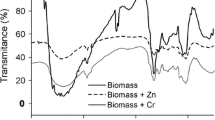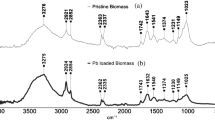Abstract
Biosorption of zinc ions by inactivated fungal mycelia was studied. Of the six fungal species, Rhizopus arrhizus, Mucor racemosus, Mycotypha africana, Aspergillus nidulans, Aspergillus niger and Schizosaccharomyces pombe, R. arrhizus exhibited the highest capacity (Q max = 213 μmol g−1 dry weight). Further experiments with different cellular fractions of R. arrhizus showed that Zn was predominantly bound to cell-wall chitin and chitosan (Q max = 312 μmol g−1 dry weight). Adsorption data were best modelled by the Langmuir isotherm, although they can be modelled by the Freundlich equation as well at relatively low aqueous concentrations. Biosorption generally decreased with increase in biosorbent particle size and its concentration. Low pH reduced Zn sorption, because of the strong competition from hydrogen ions for binding sites on fungi. The presence of ligands reduced metal uptake, chiefly by forming metal complexes of a less biosorbable nature.
Similar content being viewed by others
Author information
Authors and Affiliations
Additional information
Received: 2 November 1998 / Received revision: 12 January 1999 / Accepted: 17 January 1999
Rights and permissions
About this article
Cite this article
Zhou, J. Zn biosorption by Rhizopus arrhizus and other fungi. Appl Microbiol Biotechnol 51, 686–693 (1999). https://doi.org/10.1007/s002530051453
Issue Date:
DOI: https://doi.org/10.1007/s002530051453




